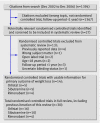Long term pharmacotherapy for obesity and overweight: updated meta-analysis
- PMID: 18006966
- PMCID: PMC2128668
- DOI: 10.1136/bmj.39385.413113.25
Long term pharmacotherapy for obesity and overweight: updated meta-analysis
Erratum in
- BMJ. 2007 Nov 24;335(7629). doi: 10.1136/bmj.39406.519132.AD
Abstract
Objective: To summarise the long term efficacy of anti-obesity drugs in reducing weight and improving health status.
Design: Updated meta-analysis of randomised trials.
Data sources: Medline, Embase, the Cochrane controlled trials register, the Current Science meta-register of controlled trials, and reference lists of identified articles. All data sources were searched from December 2002 (end date of last search) to December 2006.
Studies reviewed: Double blind randomised placebo controlled trials of approved anti-obesity drugs used in adults (age over 18) for one year or longer.
Results: 30 trials of one to four years' duration met the inclusion criteria: 16 orlistat (n=10 631 participants), 10 sibutramine (n=2623), and four rimonabant (n=6365). Of these, 14 trials were new and 16 had previously been identified. Attrition rates averaged 30-40%. Compared with placebo, orlistat reduced weight by 2.9 kg (95% confidence interval 2.5 kg to 3.2 kg), sibutramine by 4.2 kg (3.6 kg to 4.7 kg), and rimonabant by 4.7 kg (4.1 kg to 5.3 kg). Patients receiving active drug treatment were significantly more likely to achieve 5% and 10% weight loss thresholds. Orlistat reduced the incidence of diabetes and improved concentrations of total cholesterol and low density lipoprotein cholesterol, blood pressure, and glycaemic control in patients with diabetes but increased rates of gastrointestinal side effects and slightly lowered concentrations of high density lipoprotein. Sibutramine improved [corrected] concentrations of high density lipoprotein cholesterol and triglycerides [corrected] Rimonabant improved concentrations of high density lipoprotein cholesterol and triglycerides, blood pressure, and glycaemic control in patients with diabetes but increased the risk of mood disorders.
Conclusions: Orlistat, sibutramine, and rimonabant modestly reduce weight, have differing effects on cardiovascular risk profiles, and have specific adverse effects.
Conflict of interest statement
Competing interests: DCWL has received consulting and speaker fees, research grants, and travel assistance from makers of anti-obesity drugs.
Figures
Comment in
-
Review: orlistat, sibutramine, and rimonabant reduce weight in overweight and obese persons.ACP J Club. 2008 Mar-Apr;148(2):50. ACP J Club. 2008. PMID: 18311880 No abstract available.
References
-
- Haslam DW, James WPT. Obesity. Lancet 2005;366:1197-209. - PubMed
-
- Lau DCW, Douketis JD, Morrison KM, Hramiak IM, Sharma AM, Ur E. 2006 Canadian clinical practice guidelines on the management and prevention of obesity in adults and children. CMAJ 2007;176:S1-130. www.cmaj.ca/cgi/content/full/176/8/S1/DC1 - PMC - PubMed
-
- Padwal RS, Majumdar SR. Drug treatments for obesity: orlistat, sibutramine and rimonabant. Lancet 2007;369:71-7. - PubMed
-
- IMS Health. Obesity: new products on the horizon 2007. www.imshealth.com/web/end/0,3150,64576068_63872702_78348467,00.html
Publication types
MeSH terms
Substances
LinkOut - more resources
Full Text Sources
Other Literature Sources
Miscellaneous





